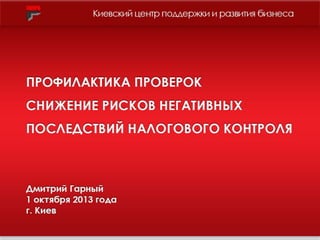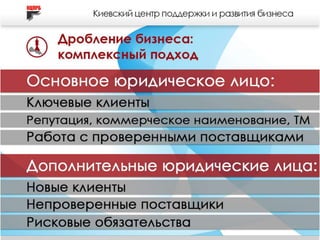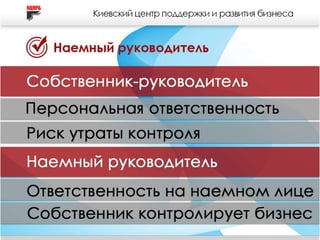Presentation (5)
Download as pptx, pdf0 likes208 views
–ü―Ä–Β–Ζ–Β–Ϋ―²–Α―Ü–Η―è –≤―΄―¹―²―É–Ω–Μ–Β–Ϋ–Η―è –î–Φ–Η―²―Ä–Η―è –™–Α―Ä–Ϋ–Ψ–≥–Ψ –Ϋ–Α –£―¹–Β―É–Κ―Ä–Α–Η–Ϋ―¹–Κ–Ψ–Φ ―³–Ψ―Ä―É–Φ–Β "–ù–Α–Μ–Ψ–≥–Η –Η –Ζ–Α―â–Η―²–Α –±–Η–Ζ–Ϋ–Β―¹–Α". –ö–Η–Β–≤, 1 –Ψ–Κ―²―è–±―Ä―è 2013 –≥–Ψ–¥–Α.
1 of 5
Download to read offline





Ad
Recommended
Alexandra tomashevskaya forum_2015_0403
Alexandra tomashevskaya forum_2015_0403Dmitriy Garniy
Χΐ
–î–Ψ–Κ―É–Φ–Β–Ϋ―² –Ψ–±―¹―É–Ε–¥–Α–Β―² –Ϋ–Α–Μ–Ψ–≥–Ψ–≤―É―é –Ω–Ψ–Μ–Η―²–Η–Κ―É –Ω―Ä–Β–¥–Ω―Ä–Η―è―²–Η–Ι –≤ –Θ–Κ―Ä–Α–Η–Ϋ–Β –Η ―¹–Ψ―¹―²–Ψ―è–Ϋ–Η–Β –Ϋ–Α–Μ–Ψ–≥–Ψ–≤–Ψ–Ι ―¹–Η―¹―²–Β–Φ―΄, –≤–Κ–Μ―é―΅–Α―è ―¹―²–Α―²–Η―¹―²–Η–Κ―É –Ϋ–Α–Μ–Ψ–≥–Ψ–≤―΄―Ö –Ω–Ψ―¹―²―É–Ω–Μ–Β–Ϋ–Η–Ι –Η –≤–Μ–Η―è–Ϋ–Η–Β –Ϋ–Α –±–Η–Ζ–Ϋ–Β―¹. –Θ–Ω–Ψ–Φ–Η–Ϋ–Α–Β―²―¹―è ―¹–Ϋ–Η–Ε–Β–Ϋ–Η–Β –Ω―Ä―è–Φ―΄―Ö –Η–Ϋ–Ψ―¹―²―Ä–Α–Ϋ–Ϋ―΄―Ö –Η–Ϋ–≤–Β―¹―²–Η―Ü–Η–Ι –Η –≤–Α–Ε–Ϋ–Ψ―¹―²―¨ –Ψ–Ω―²–Η–Φ–Η–Ζ–Α―Ü–Η–Η –Ϋ–Α–Μ–Ψ–≥–Ψ–≤ –¥–Μ―è –Ω―Ä–Β–¥–Ω―Ä–Η―è―²–Η–Ι. –û―¹–Ϋ–Ψ–≤–Ϋ―΄–Β ―Ä–Β–Κ–Ψ–Φ–Β–Ϋ–¥–Α―Ü–Η–Η –≤–Κ–Μ―é―΅–Α―é―² ―¹–Ψ–Ζ–¥–Α–Ϋ–Η–Β ―¹–Η―¹―²–Β–Φ―΄, ―¹–Ψ–Ψ―²–≤–Β―²―¹―²–≤―É―é―â–Β–Ι –Ζ–Α–Κ–Ψ–Ϋ–Ϋ–Ψ―¹―²–Η, –≥–Η–±–Κ–Ψ―¹―²–Η, –Ω―Ä–Ψ―¹―²–Ψ―²–Β –Η ―ç―³―³–Β–Κ―²–Η–≤–Ϋ–Ψ―¹―²–Η.–ü–Ψ–Μ―¨―à–Α –Κ–Α–Κ –Α–Μ―¨―²–Β―Ä–Ϋ–Α―²–Η–≤–Α –Κ–Ψ―Ä–Ω–Ψ―Ä–Α―²–Η–≤–Ϋ–Ψ–≥–Ψ –Η –Ϋ–Α–Μ–Ψ–≥–Ψ–≤–Ψ–≥–Ψ ―¹―²―Ä―É–Κ―²―É―Ä–Η―Ä–Ψ–≤–Α–Ϋ–Η―è
–ü–Ψ–Μ―¨―à–Α –Κ–Α–Κ –Α–Μ―¨―²–Β―Ä–Ϋ–Α―²–Η–≤–Α –Κ–Ψ―Ä–Ω–Ψ―Ä–Α―²–Η–≤–Ϋ–Ψ–≥–Ψ –Η –Ϋ–Α–Μ–Ψ–≥–Ψ–≤–Ψ–≥–Ψ ―¹―²―Ä―É–Κ―²―É―Ä–Η―Ä–Ψ–≤–Α–Ϋ–Η―èDmitriy Garniy
Χΐ
–ü―Ä–Β–Ζ–Β–Ϋ―²–Α―Ü–Η―è –¥–Ψ–Κ–Μ–Α–¥–Α –¦–Α―Ä–Η―¹―΄ –£―Ä―É–±–Μ–Β–≤―¹–Κ–Ψ–Ι –Ϋ–Α II –£―¹–Β―É–Κ―Ä–Α–Η–Ϋ―¹–Κ–Ψ–Φ ―³–Ψ―Ä―É–Φ–Β "–ù–Α–Μ–Ψ–≥–Η –Η –Ζ–Α―â–Η―²–Α –±–Η–Ζ–Ϋ–Β―¹–Α". –ö–Η–Β–≤, 4 –Φ–Α―Ä―²–Α 2015 –≥–Ψ–¥–Α.
–û –Ϋ–Α–Μ–Ψ–≥–Ψ–≤–Ψ–Ι ―¹–Η―¹―²–Β–Φ–Β –ü–Ψ–Μ―¨―à–Η, –≤–Ψ–Ζ–Φ–Ψ–Ε–Ϋ–Ψ―¹―²―è―Ö –¥–Μ―è ―Ä–Α–Ζ–≤–Η―²–Η―è ―É–Κ―Ä–Α–Η–Ϋ―¹–Κ–Ψ–≥–Ψ –±–Η–Ζ–Ϋ–Β―¹–Α –≤ –ü–Ψ–Μ―¨―à–Β.Iatefl presentation
Iatefl presentationChristina Nicole Giannikas
Χΐ
IATEFL, with over 4,000 members, is a significant community for English language teaching professionals, offering regular publications, an annual conference, and support for professional development. The organization has 14 special interest groups, including one focused on Young Learners and Teenagers, which connects educators globally. IATEFL also provides scholarships for members to participate in conferences and training programs.Moodle mooc4 presentation christina nicole giannikas
Moodle mooc4 presentation christina nicole giannikasChristina Nicole Giannikas
Χΐ
This document discusses the history and applications of computer-assisted language learning (CALL). It defines CALL as using computer technologies to support language teaching and learning. CALL can promote in-depth learning, increase engagement, and build global connections. However, many teachers are reluctant to integrate technology due to lack of training and support. The document advocates for action research where teachers experiment with CALL applications in their own classrooms to overcome barriers and improve practice.–¥–Β―è―²–Β–Μ―¨–Ϋ–Ψ―¹―²―¨ ―²―É―Ä–Α–≥–Β–Ϋ―²–Α ―Ä–Β–Κ–Ψ–Φ–Β–Ϋ–¥–Α―Ü–Η–Η ―é―Ä–Η―¹―²–Α
–¥–Β―è―²–Β–Μ―¨–Ϋ–Ψ―¹―²―¨ ―²―É―Ä–Α–≥–Β–Ϋ―²–Α ―Ä–Β–Κ–Ψ–Φ–Β–Ϋ–¥–Α―Ü–Η–Η ―é―Ä–Η―¹―²–ΑDmitriy Garniy
Χΐ
–ü―Ä–Β–Ζ–Β–Ϋ―²–Α―Ü–Η―è –Κ –Ψ–Ϋ–Μ–Α–Ι–Ϋ ―ç―³–Η―Ä―É –î–Φ–Η―²―Ä–Η―è –™–Α―Ä–Ϋ–Ψ–≥–Ψ. –Δ–Β–Φ–Α ―ç―³–Η―Ä–Α - ―Ä–Β–Κ–Ψ–Φ–Β–Ϋ–¥–Α―Ü–Η–Η ―é―Ä–Η―¹―²–Α ―²―É―Ä–Η―¹―²–Η―΅–Β―¹–Κ–Η–Φ –Α–≥–Β–Ϋ―²–Α–Φ. –ü―Ä–Α–≤–Ψ–≤–Ψ–Ι ―¹―²–Α―²―É―¹ ―²―É―Ä–Α–≥–Β–Ϋ―²–Α –≤ –Θ–Κ―Ä–Α–Η–Ϋ–Β, ―¹–Ψ–¥–Β―Ä–Ε–Α–Ϋ–Η–Β –¥–Ψ–≥–Ψ–≤–Ψ―Ä–Α –Ϋ–Α ―²―É―Ä–Η―¹―²–Η―΅–Β―¹–Κ–Ψ–Β –Ψ–±―¹–Μ―É–Ε–Η–≤–Α–Ϋ–Η–Β, –Ψ―²–≤–Β―²―¹―²–≤–Β–Ϋ–Ϋ–Ψ―¹―²―¨ ―²―É―Ä–Ψ–Ω–Β―Ä–Α―²–Ψ―Ä–Α –Η ―²―É―Ä–Α–≥–Β–Ϋ―²–Α –Ω–Β―Ä–Β–¥ ―²―É―Ä–Η―¹―²–Ψ–Φ.–≥–Μ–Α–≤–Ϋ―΄–Β –Ζ–Α–Κ–Ψ–Ϋ–Ψ–¥–Α―²–Β–Μ―¨–Ϋ―΄–Β –Ϋ–Ψ–≤–Α―Ü–Η–Η –¥–Μ―è –±–Η–Ζ–Ϋ–Β―¹–Α 2015
–≥–Μ–Α–≤–Ϋ―΄–Β –Ζ–Α–Κ–Ψ–Ϋ–Ψ–¥–Α―²–Β–Μ―¨–Ϋ―΄–Β –Ϋ–Ψ–≤–Α―Ü–Η–Η –¥–Μ―è –±–Η–Ζ–Ϋ–Β―¹–Α 2015Dmitriy Garniy
Χΐ
–î–Ψ–Κ―É–Φ–Β–Ϋ―² –Ψ–Ω–Η―¹―΄–≤–Α–Β―² –Κ–Μ―é―΅–Β–≤―΄–Β –Ζ–Α–Κ–Ψ–Ϋ–Ψ–¥–Α―²–Β–Μ―¨–Ϋ―΄–Β –Η–Ζ–Φ–Β–Ϋ–Β–Ϋ–Η―è –¥–Μ―è –±–Η–Ζ–Ϋ–Β―¹–Α –≤ –Ω–Β―Ä–≤–Ψ–Φ –Κ–≤–Α―Ä―²–Α–Μ–Β 2015 –≥–Ψ–¥–Α –≤ –Θ–Κ―Ä–Α–Η–Ϋ–Β, –≤–Κ–Μ―é―΅–Α―è –Ψ–±―è–Ζ–Α―²–Β–Μ―¨–Ϋ–Ψ–Β –Ω―Ä–Η–Φ–Β–Ϋ–Β–Ϋ–Η–Β –Κ–Α―¹―¹–Ψ–≤―΄―Ö –Α–Ω–Ω–Α―Ä–Α―²–Ψ–≤ –Η –Ζ–Α–Κ–Ψ–Ϋ –Ψ ―ç–Μ–Β–Κ―²―Ä–Ψ–Ϋ–Ϋ–Ψ–Ι –Κ–Ψ–Φ–Φ–Β―Ä―Ü–Η–Η. –û–Ϋ ―²–Α–Κ–Ε–Β ―É–Ω–Ψ–Φ–Η–Ϋ–Α–Β―² ―¹―É–¥–Β–±–Ϋ―É―é ―Ä–Β―³–Ψ―Ä–Φ―É, ―Ä–Β―³–Ψ―Ä–Φ―É –Ψ―Ä–≥–Α–Ϋ–Ψ–≤ –≤–Ϋ―É―²―Ä–Β–Ϋ–Ϋ–Η―Ö –¥–Β–Μ –Η –Ω―Ä–Ψ–Κ―É―Ä–Α―²―É―Ä―΄, –Α ―²–Α–Κ–Ε–Β –Φ–Β―Ä―΄ –Ω–Ψ –¥–Β―Ä–Β–≥―É–Μ―è―Ü–Η–Η –Η –Μ–Η―Ü–Β–Ϋ–Ζ–Η―Ä–Ψ–≤–Α–Ϋ–Η―é –¥–Μ―è ―É–Μ―É―΅―à–Β–Ϋ–Η―è ―É―¹–Μ–Ψ–≤–Η–Ι –≤–Β–¥–Β–Ϋ–Η―è –±–Η–Ζ–Ϋ–Β―¹–Α. –£–≤–Β–¥–Β–Ϋ–Η–Β –¥–Ψ–Ω–Ψ–Μ–Ϋ–Η―²–Β–Μ―¨–Ϋ―΄―Ö –Η–Φ–Ω–Ψ―Ä―²–Ϋ―΄―Ö ―¹–±–Ψ―Ä–Ψ–≤ –Η –Φ–Ψ―Ä–Α―²–Ψ―Ä–Η–Ι –Ϋ–Α –Ω―Ä–Ψ–≤–Β―Ä–Κ–Η –Φ–Α–Μ–Ψ–≥–Ψ –±–Η–Ζ–Ϋ–Β―¹–Α ―²–Α–Κ–Ε–Β ―è–≤–Μ―è―é―²―¹―è –≤–Α–Ε–Ϋ―΄–Φ–Η –Α―¹–Ω–Β–Κ―²–Α–Φ–Η –Ϋ–Ψ–≤―΄―Ö –Ζ–Α–Κ–Ψ–Ϋ–Ψ–≤.–ù–Α–Μ–Ψ–≥ –Ϋ–Α –Ω―Ä–Η–±―΄–Μ―¨ –Η ―²―Ä–Α–Ϋ―¹―³–Β―Ä―²–Ϋ–Ψ–Β ―Ü–Β–Ϋ–Ψ–Ψ–±―Ä–Α–Ζ–Ψ–≤–Α–Ϋ–Η–Β –≤ 2015 –≥–Ψ–¥―É
–ù–Α–Μ–Ψ–≥ –Ϋ–Α –Ω―Ä–Η–±―΄–Μ―¨ –Η ―²―Ä–Α–Ϋ―¹―³–Β―Ä―²–Ϋ–Ψ–Β ―Ü–Β–Ϋ–Ψ–Ψ–±―Ä–Α–Ζ–Ψ–≤–Α–Ϋ–Η–Β –≤ 2015 –≥–Ψ–¥―ÉDmitriy Garniy
Χΐ
–ü―Ä–Β–Ζ–Β–Ϋ―²–Α―Ü–Η―è –≤―΄―¹―²―É–Ω–Μ–Β–Ϋ–Η―è –ê–Μ–Β–Κ―¹–Β―è –®–Φ–Α―²–Κ–Ψ –Ϋ–Α II –£―¹–Β―É–Κ―Ä–Α–Η–Ϋ―¹–Κ–Ψ–Φ ―³–Ψ―Ä―É–Φ–Β "–ù–Α–Μ–Ψ–≥–Η –Η –Ζ–Α―â–Η―²–Α –±–Η–Ζ–Ϋ–Β―¹–Α". –î–Ψ–Κ–Μ–Α–¥ –±―΄–Μ –Ω–Ψ―¹–≤―è―â–Β–Ϋ –Η–Ζ–Φ–Β–Ϋ–Β–Ϋ–Η―è–Φ –≤ –ù–Α–Μ–Ψ–≥–Ψ–≤–Ψ–Φ –Κ–Ψ–¥–Β–Κ―¹–Β –Θ–Κ―Ä–Α–Η–Ϋ―΄ –Ψ―²–Ϋ–Ψ―¹–Η―²–Β–Μ―¨–Ϋ–Ψ –Ϋ–Α–Μ–Ψ–≥–Α –Ϋ–Α –Ω―Ä–Η–±―΄–Μ―¨ –Η ―²―Ä–Α–Ϋ―¹―³–Β―Ä―²–Ϋ–Ψ–≥–Ψ ―Ü–Β–Ϋ–Ψ–Ψ–±―Ä–Α–Ζ–Ψ–≤–Α–Ϋ–Η―è.Classroom climate and organization by Christina Nicole Giannikas
Classroom climate and organization by Christina Nicole GiannikasChristina Nicole Giannikas
Χΐ
The document discusses the concept of classroom climate and organization, emphasizing the importance of a compatible physical environment in fostering effective language learning. It contrasts teacher-centered and student-centered approaches, highlighting how spatial arrangements can influence student interactions, achievements, and overall classroom dynamics. The text also explores various classroom layouts, such as U-shape and circular arrangements, and their respective advantages and disadvantages for promoting engagement and communication among students.More Related Content
Viewers also liked (9)
Moodle mooc4 presentation christina nicole giannikas
Moodle mooc4 presentation christina nicole giannikasChristina Nicole Giannikas
Χΐ
This document discusses the history and applications of computer-assisted language learning (CALL). It defines CALL as using computer technologies to support language teaching and learning. CALL can promote in-depth learning, increase engagement, and build global connections. However, many teachers are reluctant to integrate technology due to lack of training and support. The document advocates for action research where teachers experiment with CALL applications in their own classrooms to overcome barriers and improve practice.–¥–Β―è―²–Β–Μ―¨–Ϋ–Ψ―¹―²―¨ ―²―É―Ä–Α–≥–Β–Ϋ―²–Α ―Ä–Β–Κ–Ψ–Φ–Β–Ϋ–¥–Α―Ü–Η–Η ―é―Ä–Η―¹―²–Α
–¥–Β―è―²–Β–Μ―¨–Ϋ–Ψ―¹―²―¨ ―²―É―Ä–Α–≥–Β–Ϋ―²–Α ―Ä–Β–Κ–Ψ–Φ–Β–Ϋ–¥–Α―Ü–Η–Η ―é―Ä–Η―¹―²–ΑDmitriy Garniy
Χΐ
–ü―Ä–Β–Ζ–Β–Ϋ―²–Α―Ü–Η―è –Κ –Ψ–Ϋ–Μ–Α–Ι–Ϋ ―ç―³–Η―Ä―É –î–Φ–Η―²―Ä–Η―è –™–Α―Ä–Ϋ–Ψ–≥–Ψ. –Δ–Β–Φ–Α ―ç―³–Η―Ä–Α - ―Ä–Β–Κ–Ψ–Φ–Β–Ϋ–¥–Α―Ü–Η–Η ―é―Ä–Η―¹―²–Α ―²―É―Ä–Η―¹―²–Η―΅–Β―¹–Κ–Η–Φ –Α–≥–Β–Ϋ―²–Α–Φ. –ü―Ä–Α–≤–Ψ–≤–Ψ–Ι ―¹―²–Α―²―É―¹ ―²―É―Ä–Α–≥–Β–Ϋ―²–Α –≤ –Θ–Κ―Ä–Α–Η–Ϋ–Β, ―¹–Ψ–¥–Β―Ä–Ε–Α–Ϋ–Η–Β –¥–Ψ–≥–Ψ–≤–Ψ―Ä–Α –Ϋ–Α ―²―É―Ä–Η―¹―²–Η―΅–Β―¹–Κ–Ψ–Β –Ψ–±―¹–Μ―É–Ε–Η–≤–Α–Ϋ–Η–Β, –Ψ―²–≤–Β―²―¹―²–≤–Β–Ϋ–Ϋ–Ψ―¹―²―¨ ―²―É―Ä–Ψ–Ω–Β―Ä–Α―²–Ψ―Ä–Α –Η ―²―É―Ä–Α–≥–Β–Ϋ―²–Α –Ω–Β―Ä–Β–¥ ―²―É―Ä–Η―¹―²–Ψ–Φ.–≥–Μ–Α–≤–Ϋ―΄–Β –Ζ–Α–Κ–Ψ–Ϋ–Ψ–¥–Α―²–Β–Μ―¨–Ϋ―΄–Β –Ϋ–Ψ–≤–Α―Ü–Η–Η –¥–Μ―è –±–Η–Ζ–Ϋ–Β―¹–Α 2015
–≥–Μ–Α–≤–Ϋ―΄–Β –Ζ–Α–Κ–Ψ–Ϋ–Ψ–¥–Α―²–Β–Μ―¨–Ϋ―΄–Β –Ϋ–Ψ–≤–Α―Ü–Η–Η –¥–Μ―è –±–Η–Ζ–Ϋ–Β―¹–Α 2015Dmitriy Garniy
Χΐ
–î–Ψ–Κ―É–Φ–Β–Ϋ―² –Ψ–Ω–Η―¹―΄–≤–Α–Β―² –Κ–Μ―é―΅–Β–≤―΄–Β –Ζ–Α–Κ–Ψ–Ϋ–Ψ–¥–Α―²–Β–Μ―¨–Ϋ―΄–Β –Η–Ζ–Φ–Β–Ϋ–Β–Ϋ–Η―è –¥–Μ―è –±–Η–Ζ–Ϋ–Β―¹–Α –≤ –Ω–Β―Ä–≤–Ψ–Φ –Κ–≤–Α―Ä―²–Α–Μ–Β 2015 –≥–Ψ–¥–Α –≤ –Θ–Κ―Ä–Α–Η–Ϋ–Β, –≤–Κ–Μ―é―΅–Α―è –Ψ–±―è–Ζ–Α―²–Β–Μ―¨–Ϋ–Ψ–Β –Ω―Ä–Η–Φ–Β–Ϋ–Β–Ϋ–Η–Β –Κ–Α―¹―¹–Ψ–≤―΄―Ö –Α–Ω–Ω–Α―Ä–Α―²–Ψ–≤ –Η –Ζ–Α–Κ–Ψ–Ϋ –Ψ ―ç–Μ–Β–Κ―²―Ä–Ψ–Ϋ–Ϋ–Ψ–Ι –Κ–Ψ–Φ–Φ–Β―Ä―Ü–Η–Η. –û–Ϋ ―²–Α–Κ–Ε–Β ―É–Ω–Ψ–Φ–Η–Ϋ–Α–Β―² ―¹―É–¥–Β–±–Ϋ―É―é ―Ä–Β―³–Ψ―Ä–Φ―É, ―Ä–Β―³–Ψ―Ä–Φ―É –Ψ―Ä–≥–Α–Ϋ–Ψ–≤ –≤–Ϋ―É―²―Ä–Β–Ϋ–Ϋ–Η―Ö –¥–Β–Μ –Η –Ω―Ä–Ψ–Κ―É―Ä–Α―²―É―Ä―΄, –Α ―²–Α–Κ–Ε–Β –Φ–Β―Ä―΄ –Ω–Ψ –¥–Β―Ä–Β–≥―É–Μ―è―Ü–Η–Η –Η –Μ–Η―Ü–Β–Ϋ–Ζ–Η―Ä–Ψ–≤–Α–Ϋ–Η―é –¥–Μ―è ―É–Μ―É―΅―à–Β–Ϋ–Η―è ―É―¹–Μ–Ψ–≤–Η–Ι –≤–Β–¥–Β–Ϋ–Η―è –±–Η–Ζ–Ϋ–Β―¹–Α. –£–≤–Β–¥–Β–Ϋ–Η–Β –¥–Ψ–Ω–Ψ–Μ–Ϋ–Η―²–Β–Μ―¨–Ϋ―΄―Ö –Η–Φ–Ω–Ψ―Ä―²–Ϋ―΄―Ö ―¹–±–Ψ―Ä–Ψ–≤ –Η –Φ–Ψ―Ä–Α―²–Ψ―Ä–Η–Ι –Ϋ–Α –Ω―Ä–Ψ–≤–Β―Ä–Κ–Η –Φ–Α–Μ–Ψ–≥–Ψ –±–Η–Ζ–Ϋ–Β―¹–Α ―²–Α–Κ–Ε–Β ―è–≤–Μ―è―é―²―¹―è –≤–Α–Ε–Ϋ―΄–Φ–Η –Α―¹–Ω–Β–Κ―²–Α–Φ–Η –Ϋ–Ψ–≤―΄―Ö –Ζ–Α–Κ–Ψ–Ϋ–Ψ–≤.–ù–Α–Μ–Ψ–≥ –Ϋ–Α –Ω―Ä–Η–±―΄–Μ―¨ –Η ―²―Ä–Α–Ϋ―¹―³–Β―Ä―²–Ϋ–Ψ–Β ―Ü–Β–Ϋ–Ψ–Ψ–±―Ä–Α–Ζ–Ψ–≤–Α–Ϋ–Η–Β –≤ 2015 –≥–Ψ–¥―É
–ù–Α–Μ–Ψ–≥ –Ϋ–Α –Ω―Ä–Η–±―΄–Μ―¨ –Η ―²―Ä–Α–Ϋ―¹―³–Β―Ä―²–Ϋ–Ψ–Β ―Ü–Β–Ϋ–Ψ–Ψ–±―Ä–Α–Ζ–Ψ–≤–Α–Ϋ–Η–Β –≤ 2015 –≥–Ψ–¥―ÉDmitriy Garniy
Χΐ
–ü―Ä–Β–Ζ–Β–Ϋ―²–Α―Ü–Η―è –≤―΄―¹―²―É–Ω–Μ–Β–Ϋ–Η―è –ê–Μ–Β–Κ―¹–Β―è –®–Φ–Α―²–Κ–Ψ –Ϋ–Α II –£―¹–Β―É–Κ―Ä–Α–Η–Ϋ―¹–Κ–Ψ–Φ ―³–Ψ―Ä―É–Φ–Β "–ù–Α–Μ–Ψ–≥–Η –Η –Ζ–Α―â–Η―²–Α –±–Η–Ζ–Ϋ–Β―¹–Α". –î–Ψ–Κ–Μ–Α–¥ –±―΄–Μ –Ω–Ψ―¹–≤―è―â–Β–Ϋ –Η–Ζ–Φ–Β–Ϋ–Β–Ϋ–Η―è–Φ –≤ –ù–Α–Μ–Ψ–≥–Ψ–≤–Ψ–Φ –Κ–Ψ–¥–Β–Κ―¹–Β –Θ–Κ―Ä–Α–Η–Ϋ―΄ –Ψ―²–Ϋ–Ψ―¹–Η―²–Β–Μ―¨–Ϋ–Ψ –Ϋ–Α–Μ–Ψ–≥–Α –Ϋ–Α –Ω―Ä–Η–±―΄–Μ―¨ –Η ―²―Ä–Α–Ϋ―¹―³–Β―Ä―²–Ϋ–Ψ–≥–Ψ ―Ü–Β–Ϋ–Ψ–Ψ–±―Ä–Α–Ζ–Ψ–≤–Α–Ϋ–Η―è.Classroom climate and organization by Christina Nicole Giannikas
Classroom climate and organization by Christina Nicole GiannikasChristina Nicole Giannikas
Χΐ
The document discusses the concept of classroom climate and organization, emphasizing the importance of a compatible physical environment in fostering effective language learning. It contrasts teacher-centered and student-centered approaches, highlighting how spatial arrangements can influence student interactions, achievements, and overall classroom dynamics. The text also explores various classroom layouts, such as U-shape and circular arrangements, and their respective advantages and disadvantages for promoting engagement and communication among students.–≥–Μ–Α–≤–Ϋ―΄–Β –Ζ–Α–Κ–Ψ–Ϋ–Ψ–¥–Α―²–Β–Μ―¨–Ϋ―΄–Β –Ϋ–Ψ–≤–Α―Ü–Η–Η –¥–Μ―è –±–Η–Ζ–Ϋ–Β―¹–Α 2015
–≥–Μ–Α–≤–Ϋ―΄–Β –Ζ–Α–Κ–Ψ–Ϋ–Ψ–¥–Α―²–Β–Μ―¨–Ϋ―΄–Β –Ϋ–Ψ–≤–Α―Ü–Η–Η –¥–Μ―è –±–Η–Ζ–Ϋ–Β―¹–Α 2015Dmitriy Garniy
Χΐ
–ù–Α–Μ–Ψ–≥ –Ϋ–Α –Ω―Ä–Η–±―΄–Μ―¨ –Η ―²―Ä–Α–Ϋ―¹―³–Β―Ä―²–Ϋ–Ψ–Β ―Ü–Β–Ϋ–Ψ–Ψ–±―Ä–Α–Ζ–Ψ–≤–Α–Ϋ–Η–Β –≤ 2015 –≥–Ψ–¥―É
–ù–Α–Μ–Ψ–≥ –Ϋ–Α –Ω―Ä–Η–±―΄–Μ―¨ –Η ―²―Ä–Α–Ϋ―¹―³–Β―Ä―²–Ϋ–Ψ–Β ―Ü–Β–Ϋ–Ψ–Ψ–±―Ä–Α–Ζ–Ψ–≤–Α–Ϋ–Η–Β –≤ 2015 –≥–Ψ–¥―ÉDmitriy Garniy
Χΐ
